The end of Tunnels: Part 1 in a 5-part series
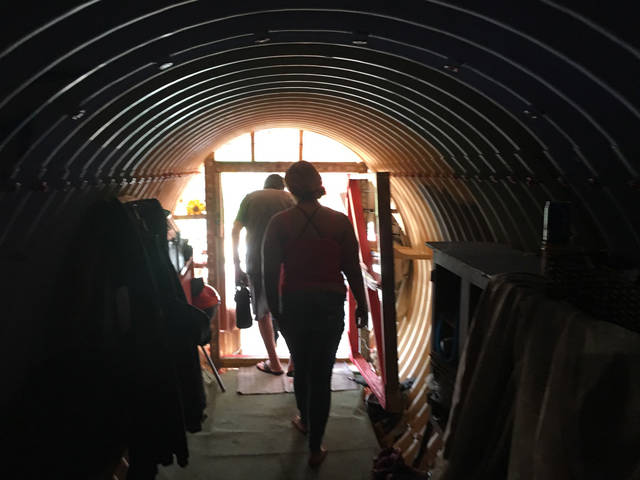
Family members leave the tunnel March 8 where Cheyanne Lee Anderson died. (Photos by Tom Hasslinger/West Hawaii Today)
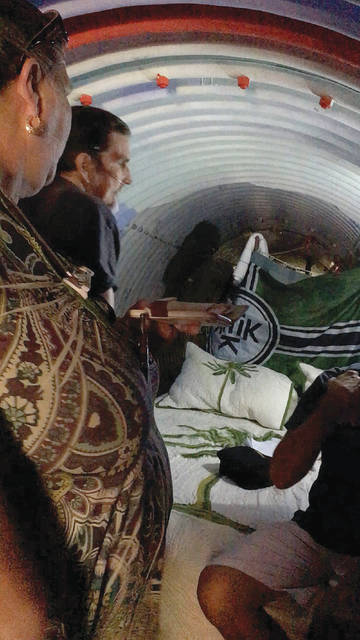
Norm Catton, second from left, looks at the spot inside the tunnels homeless camp underneath Queen Kaahumanu Highway where his stepdaughter, Cheyanne Anderson died Feb. 28. His wife and Anderson’s mother, Belinda Lee Anderson, left, joins him. Sitting on the bed in the right hand corner is former camp resident Fred Kaua. (Tom Hasslinger/West Hawaii Today)
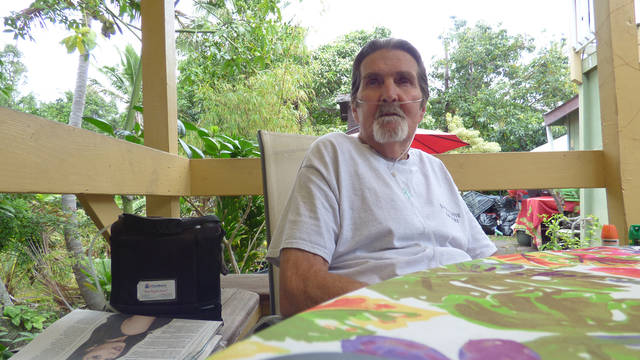
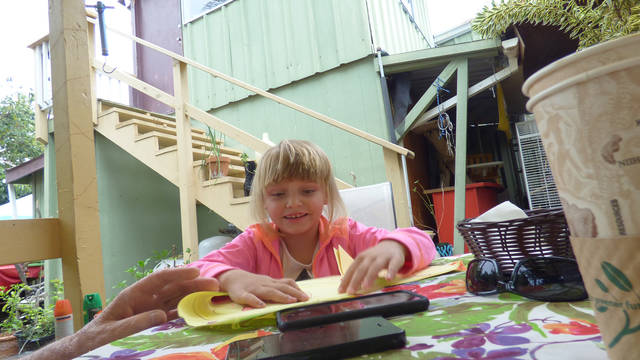
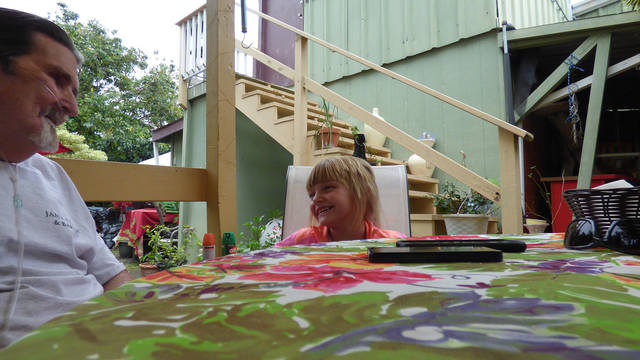
Norm Catton talks with Anderson’s daughter, Ember Anderson, March 13. (Tom Hasslinger/West Hawaii Today)
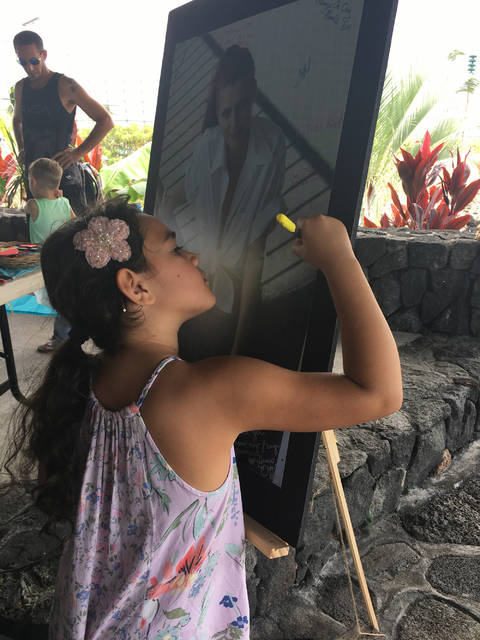
A young girl signs a picture of Cheyanne Anderson at Anderson’s celebration of life March 17 at Honokohau Harbor. (Tom Hasslinger/West Hawaii Today)
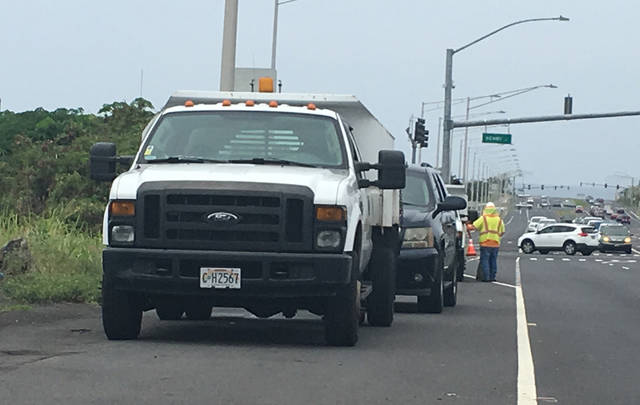
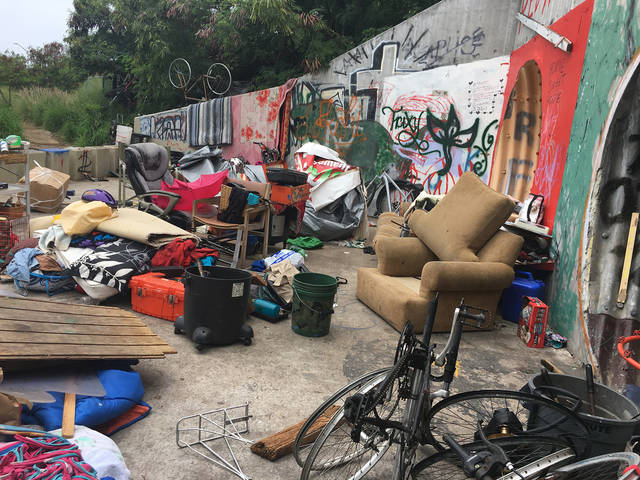
The trash heaps are shown after state workers began clearing Tunnels April 20. (Tom Hasslinger/West Hawaii Today)
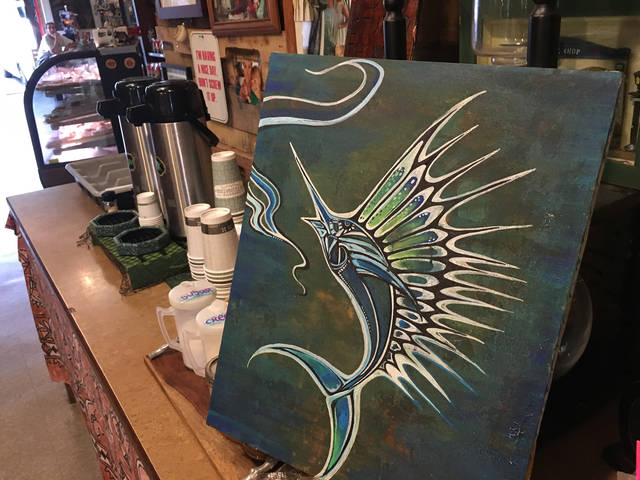
”She could look at anything, and draw it,” Cheyanne Anderson’s mother said about her late daughter’s artistic talents. A painting of a marlin Anderson drew is pictured. (Tom Hasslinger/West Hawaii Today)
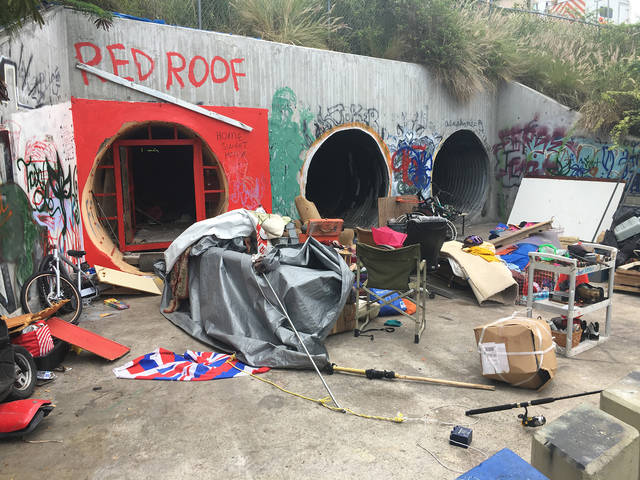
Anderson died in the far left tunnel under the red roof sign.
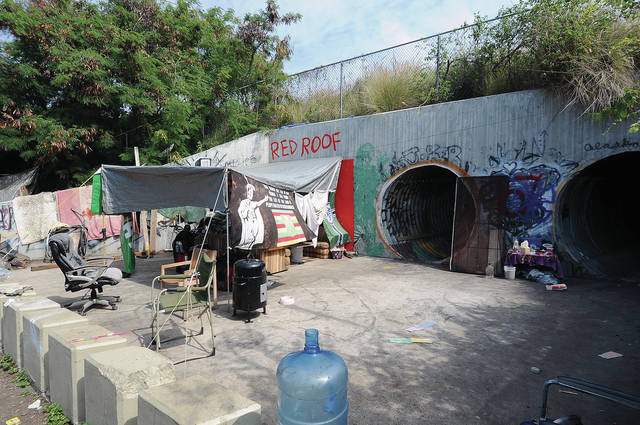
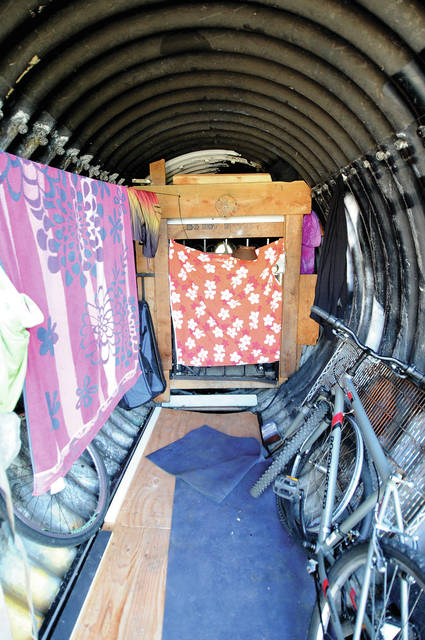
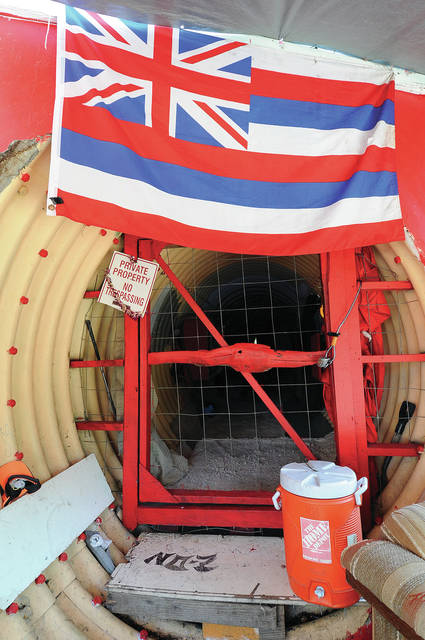
The entrance to a drainage tunnel under Queen Kaahumanu Highway is blocked off by “residents” in March. (Laura Ruminski/West Hawaii Today)
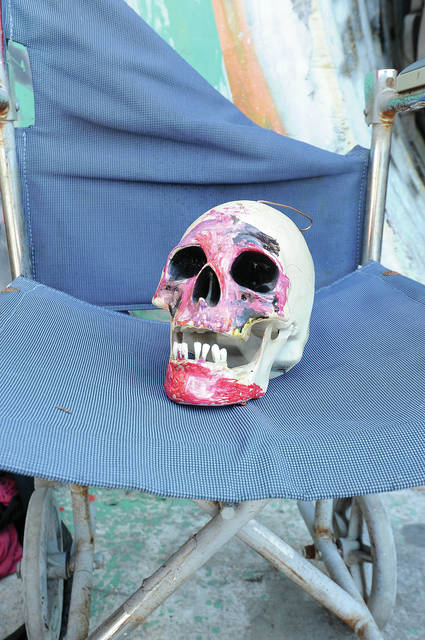
An eclectic assortment of belongings are strewn around the tunnels under Queen Kaahumanu Highway south of Henry Street. (Laura Ruminski/West Hawaii Today)
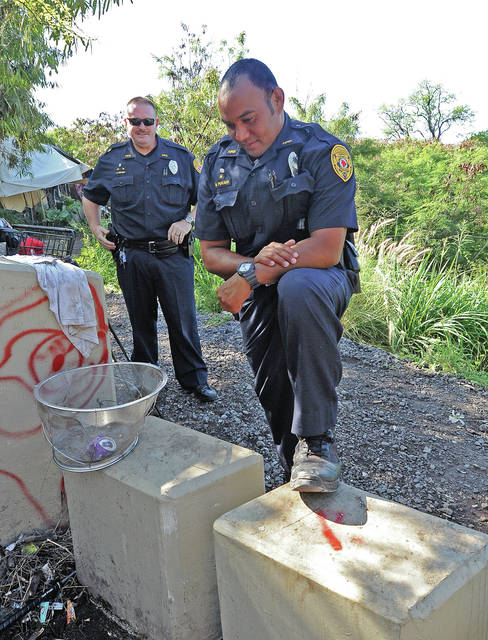
Community Policing Officers Pukahi, right, and Dewey visit the tunnels under Queen Kaahumanu Highway south of Henry Street. (Laura Ruminski/West Hawaii Today)
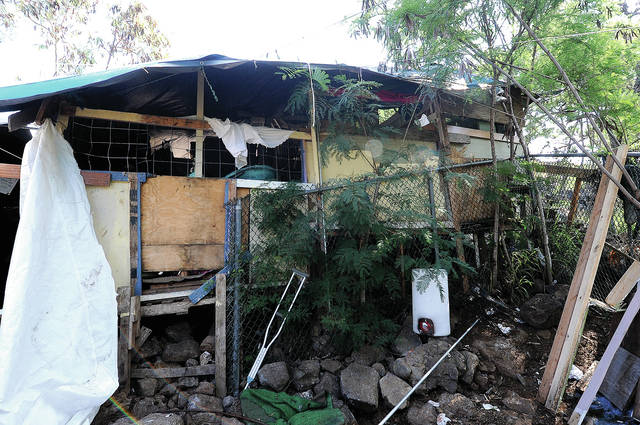
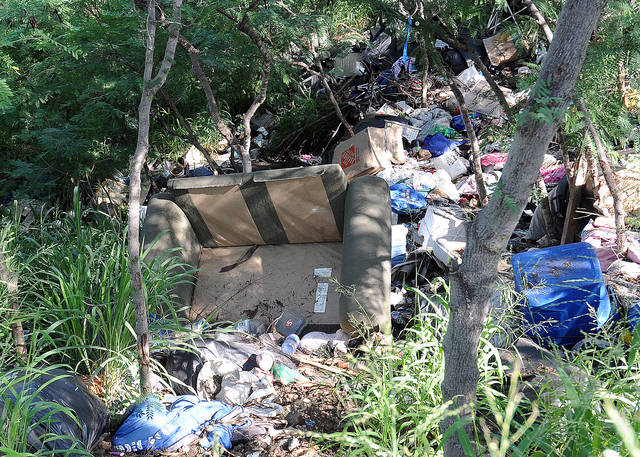
A makeshift dump site is adjacent to the drainage tunnels under Queen Kaahumanu Highway and Henry Street. (Laura Ruminski/West Hawaii Today)
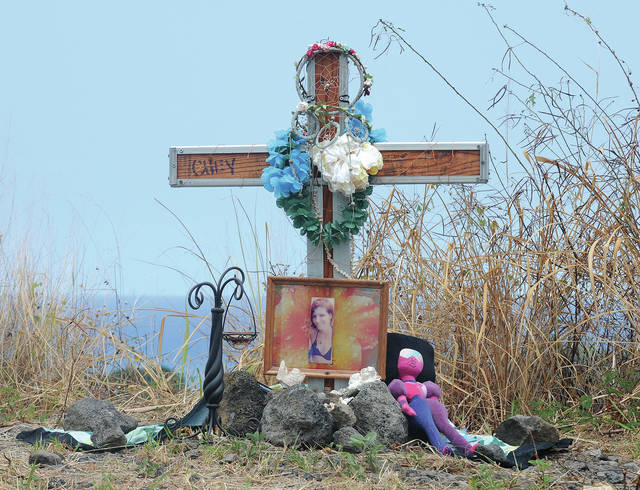
A memorial for Cheyanne Lee Anderson is erected on the side of Queen Kaahumanu Highway. (Laura Ruminski/West Hawaii Today)
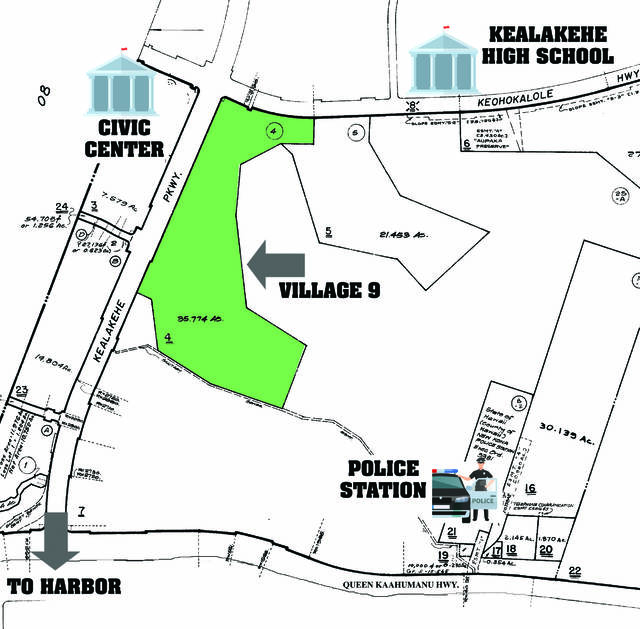
Village 9, as it’s been named, will share space on the 35.7-acre lot (shaded) with an affordable housing development operated by the state. (Map illustration/West Hawaii Today)
Editor’s note: This five-day series by West Hawaii Today focuses on opioid addiction on Hawaii Island. It begins with how a heroin overdose played a vital role in the shuttering of a well-known Kailua-Kona homeless camp and finishes on what more needs to be done to fight painkiller abuse. Eye-opening stats will be presented along the way: Hawaii County’s prescription rate doubles every other county in the state, while a vast majority of overdose calls are in homes and condos, not in homeless sites.
Editor’s note: This five-day series by West Hawaii Today focuses on opioid addiction on Hawaii Island. It begins with how a heroin overdose played a vital role in the shuttering of a well-known Kailua-Kona homeless camp and finishes on what more needs to be done to fight painkiller abuse. Eye-opening stats will be presented along the way: Hawaii County’s prescription rate doubles every other county in the state, while a vast majority of overdose calls are in homes and condos, not in homeless sites.
Day 2: Averted or inevitable? Hawaii numbers lower than mainland, but officials wary
Day 3: Figures on the front: Meeting the faces and agencies fighting against opioid abuse
Day 4: Lessons learned: Safeguards, prevention improved with knowledge gained
Day 5: Coming out the other side: More is needed in the fight, but recovery story proof it works
KAILUA-KONA — Cheyanne Lee Anderson was a talented artist until the day she died in a stormwater drain in Kailua-Kona — that much everyone involved in her life can agree on.
And she was beautiful.
Her family watched her grow up and turn boys’ heads on her way to becoming an aspiring model, the direction her life was headed before she sabotaged it with drugs.
Even early on, she had a rebellious streak. The family could always see it.
As a 16-year-old, Anderson first starting sneaking out of her bedroom window in Captain Cook to meet up with a man years her senior.
She went on to graduate Konawaena High School, but by then she was living with him, away from home.
A red flag, her stepfather, Norm Catton, now realizes.
“At the time they probably were just smoking weed,” Catton reflected back in March, four days before Anderson’s memorial service at the Big Game Fishing Clubhouse at Honokohau Harbor, where around 100 people gathered on a sunny Saturday afternoon to say goodbye and scatter the 38-year-old’s ashes in the same waters her stepfather used to fish.
Anderson died of a heroin overdose in the middle of the night on Feb. 28.
She took her last breath in one of the drainage tunnels that run mauka-makai beneath Queen Kaahumanu Highway near its intersection with Henry Street.
She died in the Tunnels, as the area was known on the street.
It was a hidden homeless camp, but well known in the circles familiar with such settlements on Hawaii Island. And it was where Anderson chose to live. Actually, she had been taken in — not just anybody could live there. One had to be invited in by a camp elder.
Rex King Jensen Jr., or RJ, was Anderson’s ticket inside the camp.
With blond hair, sun-scorched skin and bony cheeks, he’d been living there for several months and invited Anderson in after she’d burned her last bridge — kicked out of a friend’s house with nowhere else to turn. Jensen orally ingested the last hit of heroin with Anderson before they went to sleep that night. She died in RJ’s lap.
What’s difficult for Catton to fathom is how Anderson progressed from teenage rebellion to a drug overdose in a camp of drains decorated, in a way, like filthy dormitories. How could narcotics grip his stepdaughter so viciously that her addiction would leave her content — happy, by how her campmates described her — to abandon four kids and live in a tunnel?
“Her demons,” Catton said.
But what the family really can’t grasp is the camp itself — how the collection of makeshift huts and bunker-like, furnished tunnels with 14-18 inhabitants had been allowed to exist for years in the heart of Kailua-Kona, under its busiest highway, relatively untouched despite the frequent drug and alcohol abuse that took place there.
After their daughter’s death, the family questioned how such a place could thrive, hidden in plain sight. Three months later, the state cleared Tunnels in a massive sweep that netted 23 tons of trash and sent its residents in search of new shelter.
Officials said cleaning the area was on their radar since last year. That’s when the state started putting homeless outreach and cleanup plans into action, even though more permanent housing for Kailua-Kona’s chronically homeless is today still at least a year from reality.
“It’s like holy (crap), this is really going on,” Catton said. “It’s more disbelief than anything else.”
INTRODUCING TUNNELS
Tunnels was situated across the highway from the old Borders, but couldn’t be seen from the street.
It sat below thick, overgrown brush, brown and yellow in color, that doubled as an umbrella of seclusion off the side of the road. One had to walk down a steep, loosely graveled incline before the stench of squatting life hit as the first signs of a man-made walkway appeared.
There were other paths into the 1.3-acre parcel.
One was an easy trail downhill from the highway through shrubbery right off Henry Street. The clean way, Hawaii Police Department officers called it. The roughly 30-foot path goes right over the spot where a former Tunnels dweller shot and killed a man.
Police knew the camp well.
Officers are only one arm of the state’s multi-pronged approach to remove homeless campsites on state lands — the enforcement arm. Police swept the camp to search for outstanding warrants, and accompanied service providers on outreach efforts to match dwellers with resources they may need.
But they’d been told by the state Department of Transportation not to evict anyone. So for months, they didn’t — even as police investigated the death of Alanaokala Solomon Covington, the 36-year-old who was shot in the chest steps away from the drainage ditch where Anderson died. He was shot by Gafatasi Napoleon on Oct. 14, 2016, for reportedly sexually violating homeless females — a cardinal sin among camp rules, according to longstanding camp residents.
“I was the one right next to him, shoulder to shoulder, when he was shot,” Jensen, camp elder, said. “For two days, the body laid there on the ground. We walked right over it.”
Napoleon is serving 20 years for manslaughter.
Hawaii Police Department Sgt. Roylen L. Valera’s community policing officers were among the enforcement agents told to leave the camp be.
The state Department of Transportation Highways Division instructed officers it didn’t want anyone booted off the parcel because it needed resources and a plan before it could act. Not a department familiar with homeless issues until the last couple of years, it needed to coordinate any sweeps of its property with the Gov. David Ige’s Coordinator for Homelessness, Scott Morishige.
So for more than a year — several years, some camp residents estimated — it sat.
“It is what it is,” Valera said on the mostly hands-off approach officers were instructed to take. “And the police department is just one facet, but everybody thinks we’re the major player. But it’s tough because, like I said, we want to tell them where they can go — you can’t go here but you can go here — but we don’t have that place yet.”
Homelessness is a problem that has been building across the islands for the last several years.
Morishige said it has taken bureaucracy a few years to catch up with a plan to remedy it, but those plans are finally starting to come together. The Legislature closed loopholes two years ago, creating language clarifying trespassing enforcement and making it easier to carry out, while also allocating $4 million to store belongings picked up during cleanups.
This year, the Legislature allocated much more.
“The goal is not just to displace people to another property but really to try and work on a comprehensive approach that works to a long-term solution,” Morishige said. “The Department of Transportation, prior to maybe the past year, didn’t necessarily have the resources or tools to really address these issues related to unauthorized camping on their land.”
So in the interim, Valera and his team dealt with Tunnels over the years as they were instructed. Don’t target the camp, but respond to calls for service when needed.
“It’s really (crappy) having that answer, ‘I don’t know where you can go,’” Valera said of where to place Kailua-Kona’s homeless population. “I want to have that answer.”
WHERE WILL THE HOMELESS GO?
Officials have been hard at work trying to establish that elusive answer — long-term housing.
The Legislature this year appropriated $50 million for new and existing homelessness initiatives, the largest financial allocation to the issue in f history. The state has long held the dubious distinction as home to the highest per capita homelessness rate in the country.
From that $50 million, Hawaii Island is looking to land $800,000 to create a homeless family assessment center in Kailua-Kona.
The concept would appropriate 23 units at The Homes at Ulu Wini housing complex, located off Hina Lani Street above Costco, and repurpose them. Ten of the units would be converted to emergency shelters for families.
In January, Hawaii Island’s homeless count tallied nearly 869 people. The 9.6 percent decrease from the year before marked the second consecutive year numbers fell. In 2016, the count registered 1,394 homeless individuals across the county, an all-time high.
Housing for homeless has been one of Mayor Harry Kim’s major initiatives since he took office in December 2016.
A primary goal for the county is to construct Village 9, a parcel of land off Kealakehe Parkway where the county is planning a homeless site.
Monies from a pool of $30 million in state funding appropriated this session for the ohana zones concept across all islands would go toward that plan.
But that isn’t likely to be ready for at least a year, officials said. And that was before the Kilauea eruption in Puna claimed roughly 700 homes and made all the more urgent the quick need for housing.
ANDERSON’S FINAL NIGHT
Anderson died in the northern-most of the three tunnels. The tunnel had paintings on its walls. It was Anderson who colored them by night while wearing a headlamp.
Before she died, after her final dot of heroin, she was sitting on Jensen’s lap drawing on her legs. Always the artist, she treated her hair like a canvas, switching from red to purple to yellow on a whim.
“I never really knew what I was looking for,” Catton said of the final years of his stepdaughter’s life, when he couldn’t even recognize her if he saw her on the side of a road.
Had he seen her on the side of the road, he would have pulled over and begged and scolded her to get treatment.
“It sounds crazy you wouldn’t recognize your own daughter,” he said.
When Anderson was well, she always had a joke. She had a glow about her. At one point, she even graduated from Bridge House clean and sober living. She collected seashells. At 17, she was picked from a pool of 17,000 young women to go to Spain for a modeling shoot.
“She was on her way,” Catton said.
But the bad was bad. Addiction led her to abandon the modeling dream before she caught a first flight. She stole from family, and severed relationships with her own children.
Anderson died in the tunnel where Fred Kaua had been living for more than a year.
Kaua is a tall, middle-aged, articulate man with dark hair and a peaceful demeanor who was seen as a fatherly type for the camp. He moved a queen bed, complete with comforters and pillows, into the tunnel, as well as night stands and a couch.
Outside the tunnel’s mouth was a cement floor furnished like a lanai with more couches, tables, chairs and vinyl businesses signs twined together to make sunroofs.
Kaua was there after Anderson died.
“What I hear is (it was) the brown that took her out, but I’m not sure,” Kaua said, meaning heroin. “Nobody else does that around the camp. It was like she was in the wrong crowd.”
Some camp dwellers did admit to pills, alcohol and methamphetamine use.
“Vodka,” Jensen said of his vice. “I never drank until about four years ago. But when I drink. I can drink all day long. And I don’t change, I will not change. Just like now. I don’t get drunk, I don’t fall down. It’s one way to numb me a little bit. It lets me have a little bit better attitude.”
According to Jensen, a former Utah resident who said he doesn’t normally do heroin, he did the last, fateful hit with Anderson before midnight that night after leaving a friend’s place. He won’t say who gave them the drugs.
When he woke in the middle of night, Anderson wasn’t breathing. Jensen spent 15 minutes trying to revive her. She was a friend whom he says he loved.
“I knew she was gone,” he said. “But I wouldn’t accept it.”
That’s Jensen’s story on Anderson’s final hours.
But the family questions a lot of it.
Anderson’s body was outside the tunnel when Hawaii Fire Department officials responded to the scene after midnight Feb. 28, according to family. Police said she was dead upon arrival and her body was taken to the coroner’s office. Police and fire officials declined to provide reports on the death, citing family privacy and an ongoing investigation.
Nowhere on Anderson’s body was the jewelry she always had on, her family said. She died, was stripped of anything valuable by addicts, and then was left outside.
“It was gold and silver,” Belinda Lee Anderson, Anderson’s mother, said about her daughter’s favorite bracelet, which still has not been recovered. “And a ring.”
Kaua and Jensen said they didn’t know where the jewelry ended up.
“For Christ’s sake, and you didn’t shut it down? You could have prevented this,” Catton remembered saying to police when he learned the department knew the camp well, even through a homicide investigation. “It could have been another place, but it wouldn’t have been there.”
RULES INSIDE THE CAMP
The fact that Tunnels went mostly untouched for years was the best part, residents said. It acted as shade from the sun. Shade is a luxury, as is cover from rain.
“Miserable,” Kaua said. “The sun always beating down on you.”
It was also out of view. Interacting with the public can be painfully difficult, some said. Stares and looks of contempt are common, and the camp was a refuge that allowed those who resided there to “keep your pride,” as one inhabitant put it.
“When you’re homeless,” Jensen said, “it’s like there is a level of dirt on you (that) you can’t get off.”
Tunnels also ran on a loose structure.
Only those invited in by an elder could live there. There were about three elders this spring. Don’t prey on women, and don’t steal among each other, though the latter rule wasn’t followed strictly.
“It’s like for females like us, that are alone and don’t have a home,” said Jensen’s female friend, who didn’t want to give her name for the record.
She was a relatively new arrival to tunnels who talked about the rules of the camp with Jensen and West Hawaii Today two months after Anderson’s death.
“That’s a place for us to actually feel safe,” the woman said.
“They’re not going to get groped,” Jensen added. “They don’t have to worry about any of that stuff.”
Anderson’s death, some said, reflected poorly on the camp — the elders especially.
“It makes all of us look bad, you know,” Kaua said. “It’s under my watch.”
At the same time, it was remarkably unstructured.
On recent visits by a reporter in March and April, some inhabitants admitted to being hard drug users. Trash collected in piles up hill from Kailua Bay. “A toxic waste dump,” Jeffrey Closs, a family friend of the Andersons, described it. And theft from one another turned out to be commonplace.
“Stuff gets stolen,” Jensen said, “over and over and over.”
Asked if police would classify the camp as dangerous, Valera said: “Yes, based on the environment. It’s definitely somewhere you don’t want your kids.”
But as far as arrests, police have to catch drug users or criminals in the act, he said.
The same would have to be the case in regard to the stolen nylon business signs that became sunroofs.
Clearing Tunnels wouldn’t solve anything, residents said. It would just sweep people content to be under the highway into public view, without many other places to go.
“They build memorials everywhere, everywhere,” Jensen said. “At least down there, we watch each other and watch out for each other.”
On March 8, the family went to see the spot where their daughter died. They gathered on the side of the highway, then walked down to the camp together. They saw pillows, ripped paper magazines, old blankets and trash strewn about everywhere. They saw the painted tunnel walls.
“That’s definitely Cheyenne’s work,” Catton said of the art.
“I could really feel her presence,” he added later.
Closs has been a family friend of the Andersons for years. A former drug user twice-arrested, he arranged the family’s March 8 visit.
A 58-year-old reformed businessman, six years sober with a painting company, Closs knows the camping community well. A link between the two worlds, it was he and his hanai daughter — Alicia Brunette, Anderson’s good friend and also years sober — who received the phone call in the middle of the night from a tunnel dweller that Anderson had overdosed.
He classified camps as either alcoholic or drug-riddled, and agreed with the family that Tunnels should be cleaned — a memorial erected in the deceased’s honor. He couldn’t fathom why the state wouldn’t evict those who lived there, or a society that not only allowed the camp to exist, but actually condoned it.
“If you don’t want to get help and we let them live in our sewer and pollute our water and everything like that, what does that say about us as a people?” Closs said. “What does that say?”
But the campers didn’t see it that way.
It was a refuge, Kaua told them on their visit, a place and a lifestyle their daughter chose, after all.
“This is the only place the cops will let us go,” Kaua said.
Until, one day, it wasn’t.
TUNNELS GETS CLEARED
On April 20, around two weeks after West Hawaii Today called the state Department of Transportation about the parcel, the department, in coordination with the governor’s Coordinator for Homelessness, began a cleanup effort.
Notices were issued April 12 at various locations on Queen Kaahumanu Highway including Henry Street’s Tunnels, informing people in the area of the upcoming action.
Outreach workers met with seven campers to connect them with services. In the end, crews cleared approximately 23 tons of debris from the sites.
“The state continues to focus on a three-pronged framework to addressing homelessness, which includes a focus on housing, human services and public safety,” said Tim Sakahara, DOT spokesman. “HDOT began coordinating the statewide efforts in July 2017, with planning on Hawaii Island beginning more than one month ago.”
One month prior to the sweep, Anderson’s family scattered her remains in Honokohau Harbor, a favorite fishing hub of theirs, following a celebration of life service attended by more than 100 people, including Jensen, who left early because he became too uncomfortable.
Several people confronted him about providing the heroin, which Jensen denied. He sobbed at the service while wearing a long-sleeved, white collared shirt, then left by early afternoon.
“Now she’s with God,” Kailee Anderson, the eldest of Anderson’s four daughters, told the crowd. “He’ll never let her get hurt again.”
Anderson also left behind five brothers and three sisters.
A few days after the Tunnels was cleared, a few of the family members reflected on Anderson, faults and attributes — artistic, eccentric and addicted.
“She could look at anything,” her mother, Belinda Lee Anderson, said, “and draw it.”
As a teen and young adult, she’d drive her younger sisters around and pick up hitchhikers, a rebellious act of adventure in the youngers’ eyes.
“They all looked up to her,” her mother said.
It would take time to process it all, they said. They hoped the residents in Tunnels found permanent homes, got treatment and the resources they needed.
“But what was going on there wasn’t good,” Catton said.
If Anderson hadn’t died in Tunnels, it could have very well been somewhere else, they realized. Catton actually always hoped she would have been arrested and detoxed in custody.
Still.
“It’s hard to think that place took her away from all of us,” sister Marika Anderson said.
A few weeks later, in May, the family again gathered off the side of Queen Kaahumanu Highway near the intersection of Henry Street.
It was the very spot they met before they walked down the gravel incline March 8 to view the area of painted tunnel where Anderson died. One day soon, the parcel will be home to a new hotel for which plans are being finalized.
This time, though, the family stayed above the tree tops below and erected a wooden cross in memory of Anderson. They draped it in blue and white lei, with a picture of Anderson when she wore her hair red.
It stands there, a symbol, a memorial.
“A little bit of closure, I guess,” Catton said of the feeling of erecting the cross where the hidden-in-plain-sight camp used to be. “It’s a first.”



sad….but her life….her choice….her death….and this happens everyday in America……that’s the reality…get used to it
As a career (26 years) law enforcement officer in the US, now retired, my spouse is surprised how I detect signs of drug use and activity. I have concluded that denial by our ‘straight’ citizens of our nation’s drug issue makes us a nation of codependents. It just ain’t going to get any better. I recently traveled to the a Philippines and stayed four months. They have like issues there. We are not alone in the codependency issue. Allowing homelessness camps to exist with knowledge of drug use within is a huge mistake.
I am sorry that this happened. Keeping these camps open does not serve a good purpose.
Drug addiction is a medical problem, and people need permanent, safe housing as a guarantee, whether they are unable to stop using or not. The disgusting privilege of the family members blaming the fact that –gasp–people were allowed to camp together is ridiculous.
I can agree that access to medical care for illness in the US can be marginal. We pray that the addict seeks out care for their illness prior to hitting the ultimate ‘rock bottom’ as this victim. The fact is that an adult addict, prior to their first use, had knowledge that drugs can be addicting yet used the drug nonetheless. We all know where we find sympathy in the dictionary.
So, we pay Hilo “once hired, can’t be fired” folk and their
..”we need a raise” folk to:
…..Don’t target the camp, but respond to calls
…..if you die, you are stripped of anything valuable by addicts
…..some inhabitants admitted to being hard drug users
….taken bureaucracy a few years to pretend to catch up
so leeches, loafers, and druggies can “retire” to Hawaii?